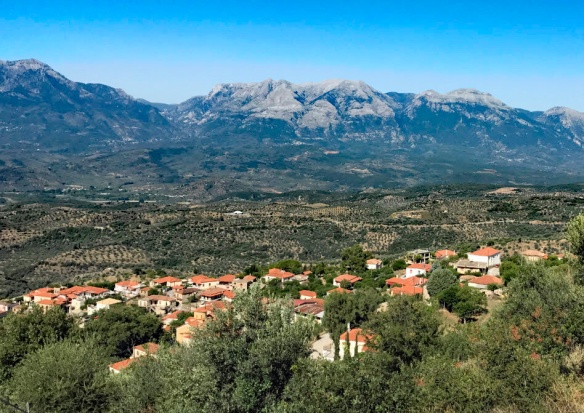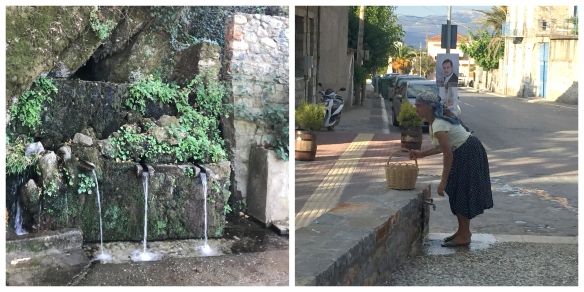by Georgia Th. Tartaris
published in The Faris Newsletter, December 2020, issue 73, pages 22-23
Note: Footnotes in the original publication have not been translated.
This photo is a little treasure. We are lucky when such small treasures come into our hands and connect us with loved ones and things of another era almost forgotten.
The person depicted in the photo is Emilia (Milia) Moutoula (1860-1940), wife of Vasileios Laskaris. She lived in the neighborhood of Laskaris, in Agia Lavra, Xirokampi. An unfortunate woman, she lost her husband early and was widowed, struggling under adverse conditions to raise her daughter Stavroula and her son Vassilis, who as a young child left for the USA, where he became successful. Later, she lost her daughter as well and supported her granddaughter Eugenia. She used to help people in need and was much loved by the villagers, who welcomed her into their homes to offer her coffee and to tell them stories about Koumousta and Xirokampi. Her name is engraved on the plaque of the benefactors of the Holy Trinity of Xirokampi, which has been posted in the narthex of the church. The photo was sent from Philadelphia, USA by her great-granddaughter Melissa Laskaris, daughter of Anastasios.

The old woman Milia is wearing a headscarf, a sack jacket and a half-skirt (or petticoat), as worn by many women of our region. The headscarf was tied in various ways: sometimes in front of the neck, sometimes behind it and sometimes behind and tied high on the head, to the side.
On top they used to wear the sack jacket, which looked like a shirt. It had buttons on the front, usually covered by a small strip of fabric, known as “patileta” to make them invisible. Underneath they wore the half-skirt or petticoat. It had a pleated sash and was tied at the side of the waist. The more fabric a woman could afford to buy, the more pleats in her half-skirt. The sack jacket fell over the half-skirt and reached to the hips.
Stavroula and Polyxeni Laskari from my own neighborhood, but also my grandmother, Georgia Tartari, née Laskari, wore the same clothes except that their skirts had fewer pleats.
I remember most of them being dressed in black; elderly women, holding onto their mourning. I remember that relatives of my grandmother’s, who were not widows, were dressed in brown. Aunt Malamo from Koumousta, who was unmarried, wore brown, as well as my great-grandmother, Artemis Mandrapilia, née Kapakos from Paliochori, married in Koumousta, who died young when she fell from a mule. I did not meet the latter, but my mother, who used to sew, often mentioned her own grandmother’s clothes.
My grandmother’s clothes were sewn by my mother. Certain women sewed clothing by themselves; others used to go to the local seamstress. The fabrics were not woven. They were purchased from the village merchants. In Xirokampi there were commercial shops: the shops of Liakakos, Theofilopoulos, Stergianopoulos. Woven clothes were worn by the older women, that I did not have the chance to meet, like my great-grandmother, and this was the difference that made my mother refer to her own grandmother’s clothes. One of the last women to keep this way of dressing was Aunt Liou Xiropodi and Panagiota Karkabasi (Karaskoutaina).
The changes in everyday life, the progress and evolution of society were factors that influenced the way people dressed. Over the years, women’s clothing changed drastically. The entry of women in a massive way into manufacturing in all sectors of the economy, the change in the family unit, and the release from prejudices and other forms of oppression fostered a new dress code for women, which was adapted to their needs.
The knowledge of the elders’ lifestyle and the transmission of this knowledge helps us to understand the evolution of society, but also the necessary changes to improve our own ways of life. All of us, more or less, have something that connects us with the past: a photograph, a piece of clothing, a tool, a piece of furniture. We are the bearers of history and its continuators. Let’s pass it on to the next generation.
I am honored and humbled to receive permission from the Katsoulakos family to translate and share articles from The Faris. Translation verification and corrections have been made by GreekAncestry.net. This is the second article of the ongoing series.




